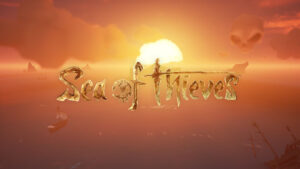
Rare has arguably had a difficult time distinguishing itself after its acquisition by Microsoft in 2002. Titles like Kameo: Elements of Power failed to launch a memorable franchise like their earlier games Battletoads, Donkey Kong Country, or Banjo-Kazooie.
Sea of Thieves is arguably Rare’s greatest success to date after joining with Microsoft. Originally released in 2018, its popularity only grew when it was made available on Microsoft’s Xbox Game Pass service.
Originally only available through Microsoft’s online store, it was recently made available on Steam, and has had numerous updates since launch.
Sea of Thieves
Developer: Rare
Publisher: Xbox Game Studios
Platforms: Windows PC (reviewed), Xbox One
Release Date: March 20, 2018
Players: 1-4
Price: $39.99
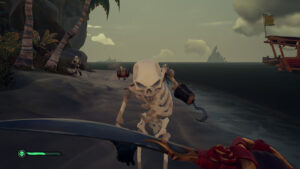
Sea of Thieves is an online adventure game where players take on the role as lovable rogues traversing the mystical and eponymous Sea of Thieves, in search of treasure and glory. Gameplay is focused on taking on voyages for one of the many companies that have established themselves in the region, each with their own goals, emphasis, and mission style.
The Merchant’s Alliance wants to build a civilization in the Sea of Thieves, and to that end they task pirates with gathering resource parcels, herding animals into cages, and making deliveries.
Many crates for the Merchant’s Alliance have some gimmick associated with them to compensate for their missions being less adventurous than the others. Crates of plants need water, jumping with a crate of rum bottles can cause them to break, and pigs herded into cages need to be fed.
The Order of Souls is interested in the esoteric history of the Sea of Thieves, and wants to put the sea’s roaming skeletons to rest. The Order tasks pirates with hunting down skeletal captains who hide on islands and spawn in waves, or engage in battle with ghostly fleets that haunt larger islands.
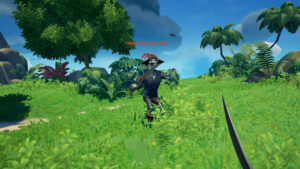
The Gold Hoarders are straightforward in their desires, in fact it’s in their name: they want gold. The Gold Hoarders task players to solve treasure maps, both in the style of “X marks the spot” and riddle maps that describe landmarks. All members of The Gold Hoarders have parts of their flesh replaced with living gold, a lingering curse from attempting to explore the mysterious Shores of Gold.
There are a few other factions but these three represent the main trading companies. When a player reaches rank 50 with at least three (usually the three mentioned above), they can become Pirate Legends and take on voyages from the ghost of The Pirate Lord himself on behalf of his own organization: Athena’s Fortune.
Players can play with anywhere from one to three other players, or play solo. The size of the party influences the minimum ship size, with a sloop having no more than two players, a brigantine no more than three, and a galleon the max of a four person party. Multiple ships can form alliances, but these are impromptu parties that are more often than not, unused.
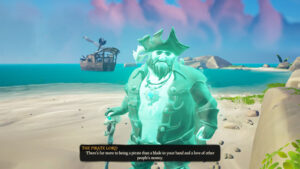
The reason for the limit likely lies in the vulnerability of the ship. Being smaller, a sloop can only take on so many holes at once. It would almost be unfair to have a fighting force of four men, as it could survive with only one man on cannons and the others repairing and steering when in a firefight.
Meanwhile galleons and brigantines have more cannons on their decks, but are less agile, and take on water much more quickly than the sloop. The trade-off is important as it allows smaller ships to fight off larger ships, and PvP is an important part of the game.
When loading in, players are deposited on one of many servers with at least a few other player ships. While the Sea of Thieves can feel vast, it gets small quick when someone is looking for a fight. Some players make a point to hunt down others; and treasure chests, skulls, and merchant crates can all be stolen by rival pirates and sold in your stead.
To that end, playing alone isn’t recommended. You could disembark on an island to hunt down skeletons, and come back to find your entire ship gone after being left unattended. Or if you’re lucky they only stole all your treasure and left your ship intact. Spawn camping is so easy and prolific, that in the respawn area players can vote to scuttle their ship and start over.
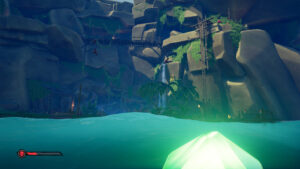
Tying into both these points; getting killed, sunk, and all your loot taken isn’t the end of the world. Sea of Thieves utilizes what it calls “horizontal progression.” All character progression is strictly cosmetic.
A new player has just as many tools at their disposal as a veteran with over a thousand hours. Which makes playing with friends all the more important, because when you gather treasure for two hours to lose everything, all you have left is the fun you had getting the loot; and that’s better enjoyed with friends.
Graphically Sea of Thieves looks good, with smooth textures, smooth water, and immersive props and design. There are a few issues like frame-rate dropping when skeletons spawn, but that might not be an issue on higher end PCs.
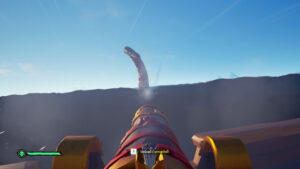
The textures are clean and smooth, and you can differentiate between a rock and a skull. Meanwhile the game has a generous draw distance to spot enemy vessels out on the water.
However some props are difficult to find even when looking for them. For instance, a treasure map for Sharkbait Cove mentions a “shark statue” to the southeast. Except there’s two statues, and one of them doesn’t even look like a shark unless you’re looking at the proper angle.
Foot combat is simple, you can swing with a sword or use one of three guns. Every player has two weapon slots, usually a sword and a gun, but it’s possible to wield two guns and risk being useless when out of ammo. Skeletons are easy to kite, but can be annoying as they spawn with a random weapon, no weapon, or carrying an explosive keg that they’ll use to suicide bomb.
Skeleton fights are also like puzzles, as some skeletons can only be hurt in certain ways. For example gold-plated skeletons can only be hurt with guns and explosives, or swords when they’re wet. Night skeletons can only be hurt during the day, or when a lantern is raised in their vicinity.
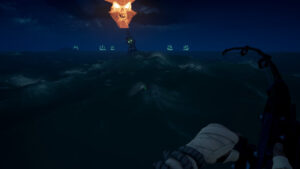
The real fun is in naval combat. It takes skill to aim cannon shots, and even more skill to do so when moving quickly as the cannon balls carry your ship’s momentum. It’s a game of accuracy, positioning, and timing.
It might be tempting to swing in close for accurate shots, but you risk being boarded and spawn camped by players. Against NPCs however it’s an excellent strategy. The AI seems to randomly fluctuate from not being able to hit you point blank, to being able to snipe you with a cursed cannon ball from forty ship-lengths away.
With how hectic the combat sounds, you’d think it’s hard to keep track of what’s happening. But Sea of Thieves does exceptionally well with its sound design and most cues are audible. A dramatic musical ditty accompanies each successful cannon shot along with a hit marker, meanwhile the boat creaks and groans to let you know you’re taking on water below deck.
When the helm or mast are damaged you hear the sound of wood splintering, and a splash of water accompanies someone emerging from the waves trying to climb aboard your ship. Even cooking gives you a cute little sizzling sound when something is finished. So much information is given through audio cues that frankly your sight is less reliable than your ears sometimes.
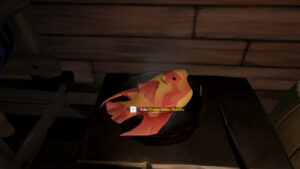
Ultimately Sea of Thieves is a PvP adventure game that likes to pretend it’s a party game, and succeeds to an extent. However the main issue is the time commitment the game requires to make any noteworthy progress.
It can take one or two hours before you’re even ready to begin thinking of turning in loot, and a fulfilling play session will take at least three hours. It’s not a game that you can just sign in and muck about for an hour at a time.
Rather than being a game that will attract narrative players, Sea of Thieves feels like a better fit for hardcore PvPers looking for a more relaxed sandbox to play in. Or for anyone who really likes pirates. Even if you’re not a hardcore PvPer but also just don’t mind the excitement that comes with it, you’ll likely have a good time.
Sea of Thieves genuinely attempts to appeal to a wide audience with its cartoonish charm, fun music, humor, and skillful naval combat; distinguishing itself as one of the best casual action games out there.
Sea of Thieves was reviewed on Windows PC using a personal copy. You can find additional information about Niche Gamer’s review/ethics policy here.